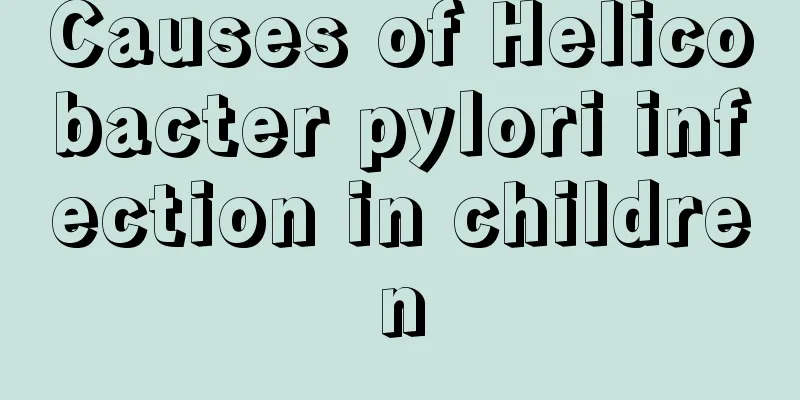Causes of Helicobacter pylori infection in children

|
There are many common diseases in children. When treating children's diseases, you need to understand the disease first. Helicobacter pylori infection in children is very common. What is the cause of Helicobacter pylori infection in children? Many parents are not clear about this. When treating Helicobacter pylori infection in children, you must understand the cause, otherwise the correct method will not be chosen for treatment. The following is a detailed introduction. Causes of Helicobacter pylori infection in children: 1. Pathogens (1) Establishment of the relationship between Hp and gastritis: A large amount of existing data supports that Hp is the pathogen of chronic gastritis. Since Hp mainly settles in the gastric mucosa after entering the body, the Hp detection rate in patients with chronic gastritis is very high, while Hp is almost never detected in normal gastric mucus. In addition, it was found that the number of Hp colonies on gastric mucus was proportional to the number of leukocyte infiltration in the gastric mucosa and positively correlated with the degree of inflammation. In adult gastritis, the main component of inflammatory activity is neutrophils; in children, lymphocytes are dominant, and the morphological changes of the mucosa under gastroscopy are mainly the formation of small nodules and small particles in the gastric antral mucosa. Macarhur et al. summarized 20 reports on Hp infection in children with gastrointestinal symptoms and found that the proportion of those with Hp infection who developed antral gastritis was significantly higher than those without Hp infection. The lowest was 1.9% and the highest was 71.0%, with an average of 11.38%. A study by Ruijin Hospital also found that the Hp infection rate in children with chronic active gastritis was as high as 96.97%, while in inactive chronic gastritis it was only 43.56%. After Hp was eliminated, the inflammation of the gastric mucosal tissue was significantly improved. Moreover, the Hp taken from the stomach of children was successfully used to infect the mouse animal model, which is consistent with the reports in foreign literature on the use of Hp artificial infection (Gnotobiotic suckling pigs, Rhesus monkeys, etc.) to produce gastritis. Hp, as a pathogen of gastritis, has met the requirements of Koch's law. It can be seen that Hp infection is closely related to the occurrence of chronic active gastritis and is an important pathogenic factor of chronic gastritis. (2) The relationship between Hp and gastric and duodenal ulcers: Although there is no record of ulcers in human volunteers and there is no animal model for this, a large amount of clinical data in adults leads people to believe that Hp infection is related to peptic ulcer disease. The most interesting evidence is that the eradication of Hp changes the natural course of peptic ulcers. After one year, the recurrence rate of ulcers has dropped from 80% after treatment with acid inhibitors alone to less than 3% after Hp eradication. The same effect has been shown in the 7-year follow-up of children with peptic ulcers. In 1994, at a special meeting hosted by the National Institutes of Health (NIH), it was announced that peptic ulcer was an infectious disease, and it was recommended that antibiotics be used to replace the previous acid-reducing treatment. The correlation between Hp and gastroduodenal ulcers in adults ranges from 70% to 100%. Since the incidence of primary ulcers in children is lower than that in adults, there are fewer literatures in this regard, but it also shows that Hp infection is associated with peptic ulcer disease. Pricto reported 91 children with H. pylori infection, of which 9 out of 12 cases (70%) had gastric ulcers and 10 out of 11 cases (90%) had duodenal ulcers. 18 articles on pediatric Hp infection and peptic ulcer data published in the United States, Canada, Spain and other countries found that in 176 cases of primary duodenal ulcers, the Hp infection rate ranged from 33% to 100%, with an average of 92%, while in 33 cases of gastric ulcers, the Hp infection rate ranged from 11% to 75%, with an average of 25%. The Department of Pediatrics of Shanghai Ruijin Hospital reported that the Hp infection rate in duodenal ulcers was 83.93%, while that in gastric ulcers was only 28.57%. These results suggest that Hp infection is closely related to primary duodenal ulcer in children. However, Hp as the cause of peptic ulcer does not satisfy Koch's law. Some authors believe that the etiological effect of Hp on peptic ulcer is indirect and related to the gastric tissue inflammation caused by Hp. Follow-up of Hp-infected individuals revealed that 1% to 6% of Hp patients had ulcerative pathological lesions and the chance of developing ulcers in Hp-infected individuals was four times that of non-Hp-infected individuals. 2. The source of infection and transmission route of Hp The source of infection and transmission route of Hp are still unclear, and there is no definite host in nature. Apart from humans, only non-human primates have natural infection and there is more evidence to prove that HP is transmitted from person to person. A study in Toronto found that 74% of parents and 82% of their children were positive for HP-IgG serum antibodies and were confirmed to have HP infection by culture. In the same study, only 24% of parents and 13% of their children were found in the control group. Obviously, close contact between people during childhood is the determining factor for the prevalence of HP. Schutze et al. further used PCR to detect the polymorphism of Hp-DNA and genotype the reinfecting strain after treatment. The results showed that the isolated reinfecting strain was almost identical to the spouse. This provides the most convincing evidence of human-to-human transmission. However, it is still unclear how Hp is transmitted from person to person. There is more evidence to support oral-oral and fecal-oral transmission. For example, Hp DNA can be detected in the patient's saliva, dental plaque, and feces through PCR. There are also reports of isolating and culturing Hp from the patient's dental plaque and feces. Recently, there have been reports of isolating the same Hp strain from multiple members of the same family. These all support the hypothesis of oral-oral and fecal-oral transmission of Hp. Some people have suggested that mothers chewing food before feeding their children or sharing a bowl when eating may be the transmission mechanism of Hp infection in developing countries, but no definite conclusion has been made on the source and transmission route of Hp. After understanding the cause of Helicobacter pylori infection in children, when alleviating the infection in children, we should pay attention to the children's diet and choose simple food. Giving children some complex food at this time will not do any good to their bodies. Parents should also know this. |
<<: Symptoms of brain dysplasia in infants
>>: Why do babies always suck their fingers?
Recommend
What does rib valgus mean?
The ribs are the most important skeletal system i...
How to prevent upper respiratory tract diseases in children?
As we all know, pediatric respiratory diseases in...
Children's safety knowledge on preventing drowning
There are many drowning incidents among young chi...
There is secretion in the female baby's lower body
It is normal for a baby girl to have white secret...
Can the Breathing Baby Cream be used?
When taking care of their babies, many mothers fi...
Are latex mattresses suitable for children?
People spend most of their lives sleeping, so how...
What are the six items of pediatric endocrinology?
Whether adults or children, whether male or femal...
What is the reason for a child to cough while sleeping?
When the temperature drops, people will catch a c...
What is the cause of the red pimples on the child's legs?
When taking care of their children, many parents ...
Symptoms of encephalitis in an 8-year-old boy
When children are young, their bodies are still i...
What should I do if a six-year-old child has a fever of 39 degrees?
Children are a family member that every parent ca...
What are the clinical manifestations of craniosynostosis?
Craniosynostosis is a common growth and developme...
Eosinophils in children
Alkaliphils are a type of white blood cell that o...
Dry and bleeding stool in baby
The nutrients needed for the baby's physical ...
What should I do if my child has diarrhea and fever?
Many mothers do not have the ability to distingui...









